Explore Chiang Saen - Thailand Travel, Asia
Standing at the meeting point of Thailand, Laos, and Myanmar, it's a must-visit location for travelers navigating the Golden Triangle, an area known for its significance both historically and geographically. Chiang Saen offers a unique blend of ancient ruins, serene riverside landscapes, and an authentic glimpse into traditional Thai life. This quiet town, far removed from the hustle of Thailand's bigger cities, invites travelers to slow down and explore its storied past, picturesque temples, and vibrant local markets.
Population: Approximately 54,000 in 2015.
Economy: Chiang Saen's economy is driven by agriculture, tourism, and cross-border trade due to its location near the Mekong River and Golden Triangle, with a growing focus on local handicrafts and eco-tourism.
Landmarks: Famous for the Wat Chedi Luang, Golden Triangle Park, and the Wat Phra That Pha Ngao.
Thailand
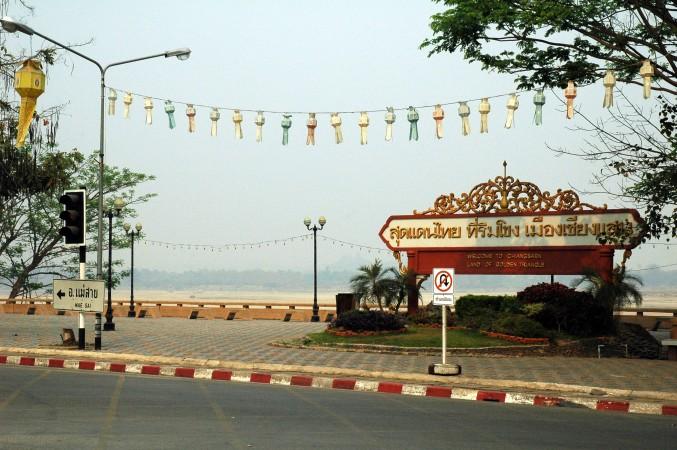
Overview of Chiang Saen
History & Cultural Influence
Chiang Saen has a long and fascinating history, tracing back to the 7th century when it was founded as a major city in the ancient Lanna Kingdom. It once stood as a key center for commerce and culture in the region, its strategic location along the Mekong River connecting it to trade routes across Southeast Asia. The city’s importance is still evident today in its well-preserved ancient ruins, temples, and monuments, which offer a window into its glorious past. In modern days, Chiang Saen’s cultural heritage continues to thrive through traditional festivals, crafts, and religious ceremonies, making it a place where history is not only remembered but also actively lived.
Interaction with the Locals
Chiang Saen has a small population of approximately 54,000 residents. The majority of its citizens belong to the Tai Lue and Tai Yai ethnic groups, which bring a rich cultural diversity to the town. The locals are known for their warm hospitality and deep-rooted traditions, with many still practicing age-old customs like almsgiving to monks and traditional weaving. Buddhism plays a central role in the lives of most residents, influencing the town’s festivals, daily rituals, and overall way of life.
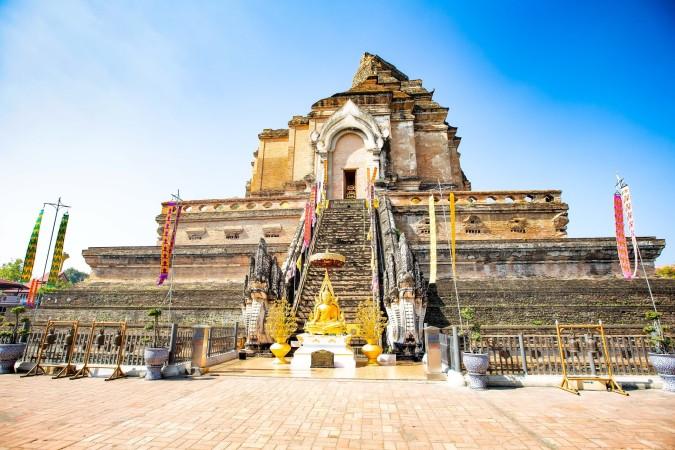
Wat Chedi Luang - © Josh Ellis Photography
Top Attractions in Chiang Saen
Chiang Saen’s must-visit attractions are a blend of natural beauty and ancient wonders. Whether you’re an avid history enthusiast or just looking for peaceful scenic views, the town has something to offer for everyone.
- Wat Chedi Luang: One of the most iconic temples in Chiang Saen, Wat Chedi Luang is known for its massive ancient chedi that dates back centuries. It stands as a testament to the region's architectural prowess and is a must-visit for any traveler.
- Golden Triangle Park: The Golden Triangle Park, a short drive from Chiang Saen, offers breathtaking views of Thailand, Laos, and Myanmar. The panoramic vistas of the Mekong River and the surrounding mountains are breathtaking, making it one of the top photography spots in the area. You can also visit the Hall of Opium, a museum dedicated to the history of the region’s opium trade.
- Wat Phra That Pha Ngao: This serene temple, perched on a mountain just outside of town, provides breathtaking views of the Mekong. It’s the perfect place for quiet reflection and enjoying nature, with the temple grounds dotted by beautiful stupas and Buddha statues.
- Chiang Saen Lake: For those who enjoy nature, Chiang Saen Lake is an ideal spot for bird watching and relaxation. Surrounded by lush greenery, the lake provides a peaceful escape from the town’s more historical attractions. You can also rent a boat and explore the lake’s calm waters.
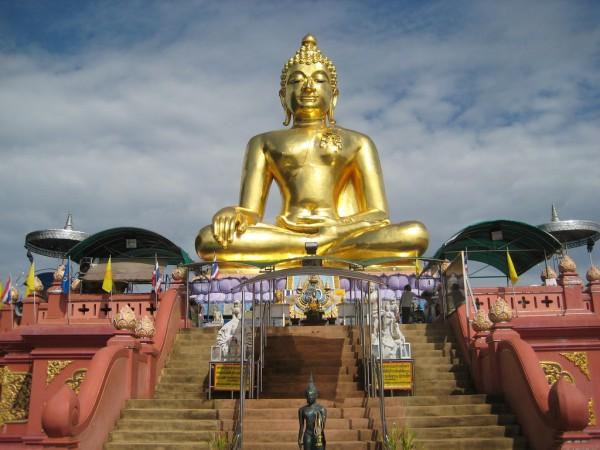
Golden Triangle Park - © Flickr (@Gigi Fotos)
Must-Try Dishes in Chiang Saen
Chiang Saen's culinary tradition is a must-explore for food lovers looking to experience the rich flavors of Northern Thai cuisine. Influenced by nearby Laos, Myanmar, and the local Lanna culture, the dishes here are packed with herbs, spices, and fresh ingredients.
- Khao Soi: A Chiang Saen specialty, this creamy, curry-based noodle soup is a favorite among both locals and travelers. It combines crispy fried noodles and soft egg noodles, topped with tender chicken or beef, in a rich coconut curry broth.
- Nam Prik Ong: A Northern-style chili dip made with tomatoes, minced pork, and dried chilies, Nam Prik Ong is commonly served with fresh vegetables and sticky rice. The dip is spicy but balanced with the sweetness of tomatoes, offering a unique flavor.
- Larb Moo Kua: A variation of the popular Thai minced pork salad, Larb Moo Kua is Chiang Saen’s take on this classic dish. It’s made with minced pork, seasoned with roasted spices and herbs, and served with fresh vegetables.
- Gaeng Om: A lesser-known Northern Thai dish, Gaeng Om is a herbal stew made with pork or beef, mixed vegetables, and a variety of fresh herbs like lemongrass, dill, and kaffir lime. This dish has an earthy, aromatic flavor and is loved for its warmth and comforting qualities.
- Nam Ngiao: This spicy noodle soup is made with rice noodles and a pork and tomato-based broth. Nam Ngiao is packed with flavor from a mix of dried chilies, fermented soybeans, and herbs.
- Moo Nam Tok: Another Northern Thai favorite, Moo Nam Tok is a grilled pork salad mixed with roasted rice powder, mint, shallots, and a tangy lime dressing. The flavors are a perfect balance of savory, spicy, and sour, and it's often served with sticky rice.
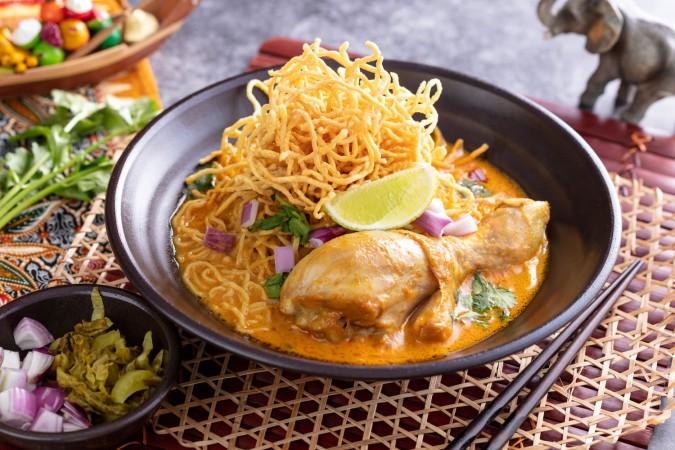
Khao Soi - © Asian Inspirations
Festivals & Local Celebrations
Chiang Saen's festivals are vibrant, colorful, and deeply rooted in Buddhist traditions and the region’s cultural heritage. These celebrations offer travelers a unique opportunity to experience the town's community spirit and traditional practices.
Songkran Holiday (Thai New Year)
Celebrated in mid-April, Songkran is the largest and most famous festival in Chiang Saen, marking the traditional Thai New Year and is a time for paying respects to elders, visiting temples, and, most famously, participating in water fights. Locals and tourists alike enjoy splashing water on each other to symbolize the washing away of the past year's misfortunes.
Loi Krathong
Held every November, Loi Krathong is the festival of lights. During this celebration, locals make beautiful lotus-shaped baskets (krathongs) and release them into the river to pay homage to the water spirits. Chiang Saen’s proximity to the Mekong River makes it an especially magical place to experience this festival, with hundreds of floating lanterns lighting up the water.
Boat Racing Festival
Chiang Saen’s boat racing festival is a thrilling annual event that takes place along the Mekong River. Teams from neighboring regions come together to compete in longboat races, creating a lively atmosphere filled with music, food, and cheering spectators.

Songkran Holiday - © Euronews
What to Do in Chiang Saen
- Mekong River Boat Tours: One of the most popular activities in Chiang Saen is taking a boat ride along the Mekong River. These tours provide breathtaking views of the surrounding landscapes and the opportunity to see the famous Golden Triangle, which connects Thailand, Laos, and Myanmar.
- Trekking & Cycling: The hills and trails around Chiang Saen are perfect for trekking and cycling. Visitors can explore scenic paths, visit hill tribe villages, and discover hidden waterfalls and natural reserves. Guided tours are recommended for those who want a more immersive experience with knowledgeable local guides.
- Visiting Temples and Ancient Ruins: As a town rich in history, Chiang Saen is home to many ancient temples and historical sites. Spend the day exploring Wat Chedi Luang, Wat Pa Sak, and the ruins of the Lanna Kingdom, each offering a unique glimpse into the town’s storied past.
- Exploring Local Markets: Chiang Saen's markets are vibrant and full of local flavor. Visit the Chiang Saen Walking Street Market to shop for handmade crafts, textiles, and traditional Northern Thai snacks. These markets provide an excellent opportunity to experience local life while also supporting small businesses.
Shopping in Chiang Saen
- Handicrafts Stores: One of the best things to shop for in Chiang Saen is handmade crafts created by local artisans. These include hill tribe textiles, intricate wood carvings, and silver jewelry. Many of these items are made using traditional techniques passed down through generations, making them perfect souvenirs or gifts.
- Local Markets: Chiang Saen is known for producing high-quality silk, pottery, and herbal teas. Visitors can purchase these products directly from the artisans or in local markets, ensuring an authentic shopping experience. Look for traditional woven fabrics that showcase the craftsmanship of the local Tai Lue and Tai Yai communities.
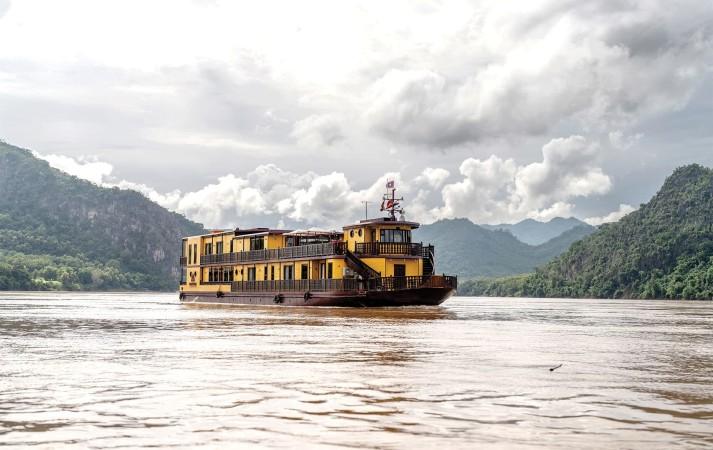
Mekong River Boat Tours - © VIE Magazine
Weather in Chiang Saen: Best Time to Visit
Chiang Saen, located in Northern Thailand, experiences a tropical climate with two distinct seasons. Understanding the weather will allow you to plan your vacation for the best possible experience.
Dry Season in Chiang Saen
This is the best time to visit Chiang Saen and has an ideal exploration. The temperatures during the day are delightfully mild, ranging from 15°C to 28°C (59°F to 82°F), with cooler nights and early mornings. The clear skies and refreshing air make it ideal for sightseeing, exploring temples, and outdoor activities such as cycling and trekking.
Wet Season in Chiang Saen
During this period, Chiang Saen receives regular rainfall, which helps cool down the temperature. Expect intermittent showers, with some heavy downpours in July and August. While it’s less crowded with tourists, the lush greenery and refreshing atmosphere make it an excellent time to visit if you don’t mind occasional rain.

Explore Wat Phra That Pha Ngao - © Chiang Rai & Phayao
Essential Travel Information
Getting Around Chiang Saen
- Tuk-Tuks: Tuk-tuks are readily available in Chiang Saen and are a fun and convenient way to travel around the town for short distances.
- Songthaews: These are shared pickup vehicles with benches in the back that serve as public transit. They run on set routes and are a cost-effective way to get around.
- Bicycle & Motorbike Rentals: For those who prefer more flexibility, renting a bicycle or motorbike is a great option. Chiang Saen is small enough to explore by bike, and motorbikes offer more range for visiting nearby attractions such as the Golden Triangle.
- Car Rentals: If you’re planning to explore the surrounding areas extensively, renting a car from Chiang Rai or Chiang Saen is an option. The roads are generally in good condition, and driving gives you more control over your itinerary.
ATM & Banking Services
In Chiang Saen, ATMs are widely available, especially in the town center and near popular tourist spots, making it easy to withdraw cash using international debit or credit cards. While many businesses, including larger hotels and some restaurants, accept cards, smaller markets and local vendors typically operate on a cash-only basis, so it's a good idea to have enough Thai Baht on hand for smaller purchases. Currency exchange services are accessible in town, though it's often more convenient to exchange money in larger cities or at airports before arriving.
Where to Stay in Chiang Saen
- Riverside Resorts: For those looking for a touch of luxury with stunning views, Chiang Saen’s riverside accommodations offer a relaxing experience with scenic vistas of the Mekong River. These resorts often come with amenities like swimming pools, spa services, and on-site dining, providing a perfect base for exploring nearby attractions while enjoying comfort and tranquility.
- Boutique Hotels & Homestays: Travelers who prefer a more intimate and local experience will find a wide selection of boutique hotels and charming homestays. These smaller accommodations offer personalized service, a homely atmosphere, and affordable pricing, ideal for those seeking comfort with a local touch.
- Hostels: Backpackers and budget-conscious travelers will appreciate the variety of affordable hostels and budget guesthouses available in Chiang Saen. These options provide clean, comfortable lodging with basic amenities, allowing travelers to save money while exploring the area.
Articles for you

Explore Yala National Park - Sri Lanka Travel, Asia
Tucked away in Sri Lanka’s southeastern corner, Yala National Park is where wild nature meets deep tradition. Known worldwide for its leopard population, the park is also home to elephants, sloth bears, crocodiles, and hundreds of bird species. Beyond wildlife, Yala opens doors to a cultural landscape dotted with ancient temples, Buddhist ruins, and coastal villages. For travelers seeking more than just a safari, Yala offers a chance to explore eco-tourism, local communities, and sacred heritage sites.
Population: The Yala National Park area doesn’t have a human population.
Economy: The economy around Yala National Park thrives on a blend of eco-tourism, agriculture, and local services. Safari tours, eco-lodges, and cultural experiences drive steady income for nearby towns like Tissamaharama and Kataragama, supporting thousands of families.
Landmarks: Famous for Block I of Yala and wildlife encounters, including elephants, sloth bears, crocodiles, and exotic bird species.

Explore Galle - Sri Lanka Travel, Asia
Nestled on Sri Lanka’s southern coastline, Galle is a vibrant city where history meets the sea. Its cobbled streets, colonial architecture, and serene beaches make it a must-visit destination for travelers seeking a blend of culture, adventure, and relaxation. A UNESCO World Heritage site, Galle captivates visitors with its Dutch Fort, bustling markets, and friendly locals. Whether you’re exploring the ramparts at sunset or savoring fresh seafood by the shore, Galle promises an unforgettable journey into Sri Lanka’s heritage.
Population: Approximately 113,000 in 2023.
Economy: Galle’s economy thrives on tourism, trade, and fisheries. The city’s historic fort, colonial architecture, and coastal charm draw thousands of international visitors each year, making tourism its main economic driver. Fishing remains vital for local livelihoods, supplying fresh seafood across the region.
Landmarks: Famous for the Galle Fort, Dutch Reformed Church & Maritime Museum, and Unawatuna Beach.

Explore Bentota - Sri Lanka Travel, Asia
Nestled along Sri Lanka’s southwestern coast, Bentota is a tropical paradise that blends golden beaches, vibrant culture, and thrilling adventures. Famous for its calm waters, luxury resorts, and scenic river estuary, Bentota has become a top destination for travelers seeking both relaxation and authentic experiences. From serene beach walks at sunrise to adrenaline-pumping water sports, this coastal town offers a perfect balance of leisure and exploration. With its proximity to Colombo and Galle, Bentota is easy to reach, making it an ideal stop for both short escapes and extended holidays.
Population: Approximately 37,000 in 2023.
Economy: Bentota’s economy thrives mainly on tourism, which drives local businesses such as hotels, restaurants, and wellness retreats. The town also benefits from fishing, coconut cultivation, and handicrafts like wood carving and batik textiles. Many residents rely on the growing demand for water sports and Ayurvedic treatments, making tourism the backbone of both income and employment in the area.
Landmarks: Famous for Bentota Beach, Bentota River Safari, and Kande Vihara Temple.

Explore Mirissa - Sri Lanka Travel, Asia
Mirissa is a charming coastal town on Sri Lanka’s southern shoreline. Known for its golden beaches, turquoise waters, and vibrant marine life, it has become a must-visit stop for travelers exploring the island. Many come for whale watching, surfing, and sunset views at Coconut Tree Hill, but Mirissa offers much more than postcard beauty. The fishing boats you see anchored by the bay carry generations of stories. Local traditions, delicious cuisine, and a laid-back rhythm of life shape every visitor’s experience.
Population: Approximately 4,700 in 2023.
Economy: Mirissa’s economy is largely shaped by its coastal location. Fishing has long been the backbone of local livelihoods, with generations relying on the Indian Ocean for income. In recent decades, tourism has become the main driver of growth, thanks to whale watching, surfing, and beachside hospitality.
Landmarks: Famous for Mirissa Beach, Coconut Tree Hill, and Parrot Rock Bridge.

Explore Nuwara Eliya - Sri Lanka Travel, Asia
Tucked away in the Central Highlands of Sri Lanka, Nuwara Eliya is often called “Little England”. With its rolling tea plantations, cool misty mornings, and colonial charm, this mountain town feels like a step into another world. Travelers come here to breathe fresh air, walk through flower gardens, sip the finest Ceylon Tea, and enjoy a pace of life far from the island’s busy cities. Whether you’re drawn by scenic landscapes, heritage architecture, or the warmth of its people, Nuwara Eliya is a destination that blends nature, culture, and history in perfect harmony.
Population: Approximately 781,000 in 2023.
Economy: Nuwara Eliya’s economy thrives mainly on tea production, as it sits in the heart of Sri Lanka’s central highlands, famous worldwide for Ceylon Tea. The city also benefits from a growing tourism industry, attracting visitors with its colonial charm, cool climate, and scenic landscapes.
Landmarks: Famous for Gregory Lake, Hakgala Botanical Garden, and Victoria Park.

Explore Sukau - Malaysia Travel, Asia
Nestled on the banks of the Kinabatangan River in Sabah, Malaysian Borneo, Sukau is a destination where wildlife, culture, and conservation come together. Known as one of Asia’s top spots for river safaris and eco-tourism, this quiet village offers a front-row seat to encounters with Bornean orangutans, pygmy elephants, proboscis monkeys, and exotic birdlife.
Population: Approximately 1,400 in 2019.
Economy: Sukau’s economy is shaped by its riverine location and natural resources. Traditionally, the Orang Sungai community relied on fishing, small-scale farming, and forest gathering for their livelihood. Today, the village has shifted toward eco-tourism, with river cruises, jungle trekking, and homestays providing income.
Landmarks: Famous for the Kinabatangan River cruises, Gomantong Caves, and Ox-bow lakes and wetlands.
